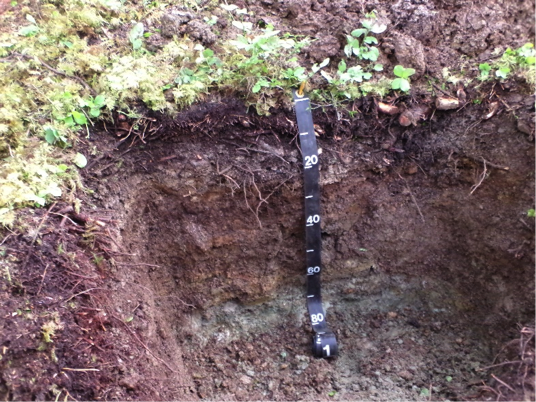Marjorie Robinson
I don’t remember what I used to picture when the words ‘field science’ came into mind. Perhaps I pictured a fun, easy going process in which samples were ready for the taking. Little did I know the time extensive, physically and emotionally exhausting process it is. I categorized the two difficulties that I believed were apparent throughout this process. Number one in these difficulties is location. Our CAUSE group took on the challenge of trekking through inclined forested areas, mosquito laden shrubbery, and muddy pits, which took on the role of quicksand for our beloved muck boots. Our hikes would vary from 15 to 40 minutes depending on our site location, but the tree roots, branches and devil’s club ensured that the feeling of a tortuous never ending hike remained.

Our group dug up this soil pit in a PFO site, in order to classify the soil, and thus classify the land as a wetland.
Despite our difficulties, a feeling of satisfaction overcame me whenever we arrived at our sites. The location of our site also determined the level of difficulty it would take to retrieve our samples, dig our soil pits, take our soil cores, or retrieve peat depths. The different types of wetland we worked on were, Palustrine Forested Wetlands (“PFO”), Palustrine Scrub-Shrub Wetlands (“PSS”), and Palustrine Emergent Wetlands (“PEM”). These systems brought a series challenges for our team. For instance, in one of the PFO sights, we had difficulty digging a soil pit because of large tree roots and stumps embedded deep in the soil, so the process took longer than expected. On the other hand, in a PSS, the major challenges were avoiding the muddy pits while taking peat depths and bailing out water from our flooding soil pit.

Courtney (right) and I taking peat depths using a 3 meter probe. Courtney is smiling because the probe is sliding through with no obstructions. This location is known as a Palustrine Scrub-Shrub (Palustrine meaning: not associated with a stream). The name of this site is Chocolate Lab (CL) because of all of the muddy pits.
The second difficulty that drained me was luck. I’m typically not a lucky person. I know the common conception is that with preparation, no luck is needed; however, after taking peat depths and soil cores and watching my fellow peers struggle, I’ve changed views. PFO wetland systems presented a definite challenge with peat depths, seeing as every time the probe was inserted, you’d hit nothing but roots; when the moment would come that a peer would hit silt or mineral, a light illuminated brightly within their eyes. The sound of our probe hitting mineral became our favorite song, and we had to do this every 10 meters along 50 by 50 meter transects. I remember Ian and Shannon being so relieved at finally hitting mineral in a PFO site, and by that time they’d tried probing more than 10 times until they were successful. It became a fun game of ‘point and probe’.
There are obvious challenges in any type of field work, no matter the discipline, but the challenges we were presented with didn’t overshadow our appreciation and love of the science involved. There’s also bonding and a sense of community in working together towards a common goal, and that’s something I’ll never forget about this experience. All in all, based on my experiences in Alaska, I’d have to say you get from field science what you put into it. A positive attitude goes a long way, even in factual science.

